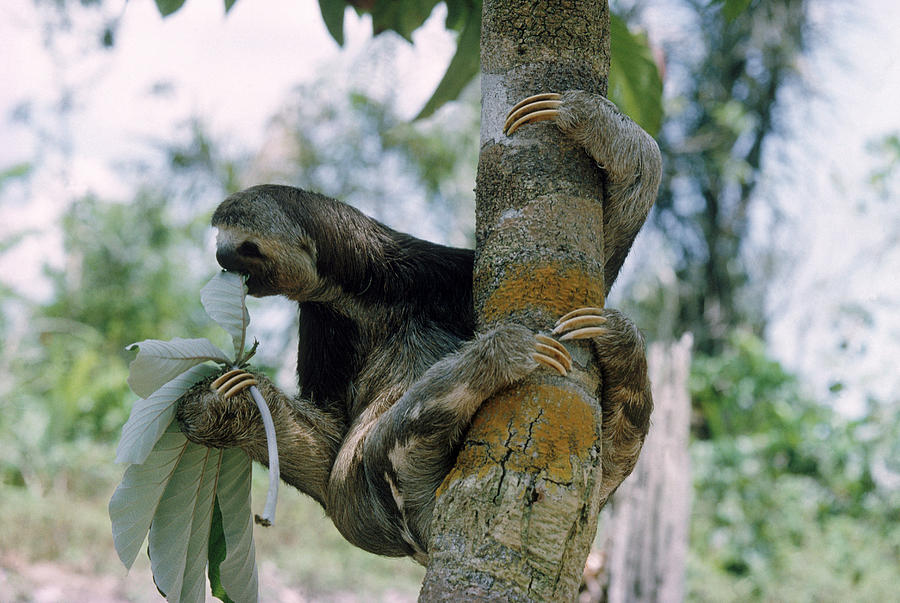

J Anthropol Sci 84:7–32ĭuarte DPF, Costa CP, Huggins SE (1982) The effects of posture on blood pressure and heart rate in the three-toed sloth Bradypys tridactylus. MPhil thesis, Universidade Federal de Rio de Janeiro, Rio de Janeiro, Brazilĭonati G, Borgognini-Tarli SM (2006) From darkness to daylight: cathemeral activity in primates. Florida University Press, Gainesville, pp 269–280Ĭonsentino LN (2004) Aspectos do comportamento da preguica comum, Bradypus variegatus (Xenarthra, Bradypodidae) em uma área de semi-cativeiro no município de Valença-Rio de Janeiro.

In: Vizcaíno SF, Loughry WJ (eds) The biology of Xenarthra. J Zool 246:1–10Ĭhiarello AG (2008) Sloth ecology: an overview of field studies. Brasilconsult, RecifeĬhiarello AG (1998) Activity budgets and ranging patterns of the Atlantic forest maned sloth Bradypus torquatus (Xenarthra: Bradypodidae). Edentata 11:62–69ĬHESF (2004) Relatório Final da Fase I do Programa de Monitoramento da Fauna, na área de Influência da linha de transmissão 230 kV Recife II/ Pau Ferro. MPhil thesis, Universidade Estadual de Santa Cruz, Bahia, BrazilĬastro-Vásquez L, Meza M, Plese T, Moreno-Mora S (2010) Activity patterns, preference and use of floristic resources by Bradypus variegatus in a tropical dry forest fragment, Santa Catalina, Bolívar, Colombia. MPhil thesis, Universidade Federal do Amazonas, Amazonas, BrazilĬassano CR (2006) Ecologia e conservação da preguiça-de-coleira ( Bradypus torquatus Illiger, 1811) no sul da Bahia. Science 90:16–17Ĭarmo NAD (2002) Distribuição, densidade, padrão de atividades, dieta e parasitas de Bradypus tridactylus (Mammalia, Xenarthra) em fragmento florestal na Amazonia Central. Zoologica 7:1–67īritton SW, Kline RF (1939) On deslothing the sloth.

Behavior 49:227–267īeebe W (1926) The three-toed sloth Bradypus cuculliger cuculliger Wagler. J Anim Ecol 70:980–986Īltmann J (1974) Observational study of behavior: sampling methods. These data suggest that with decreased predator presence and with a more ubiquitous food source, sloths adjust their temporal niche to daytime.Īlanara A, Burns MD, Metcalfe NB (2001) Intraspecific resource partitioning in brown trout: the temporal distribution of foraging is determined by social rank. Furthermore, several behaviors were expressed in a bimodal pattern, with a morning and a late afternoon peak of activity. Unlike sloths located in an undisturbed forest, this population exhibited primarily diurnal activity patterns of behavior, with the center of gravity for each behavior occurring in the middle of the day.
THREE TOED SLOTH SERIES
Time series data were subjected to X 2 periodogram, Fourier (Fast Fourier Transformation, FFT), cosinor and CircWave circadian rhythm analysis, and revealed significant 24-h rhythms in all behaviors in most circumstances. Observational data were collected in 15 min increments over the 24-h day in the following categories: resting, moving, travelling, eating and grooming. Three adults (2 females and 1 male) and 2 infants were studied over 29 days. variegatus) living in the border of a highly disturbed forest fragment in northeastern Brazil. We evaluated activity pattern, time budget and rhythmic activities of brown-throated three-toed sloths ( B. In the current study we wished to examine sloth behavior in a highly disturbed secondary forest habitat. Previous studies exploring the rhythmic activity of sloths of the Bradypus genus in undisturbed forests revealed cathemeral patterns of activity.


 0 kommentar(er)
0 kommentar(er)
